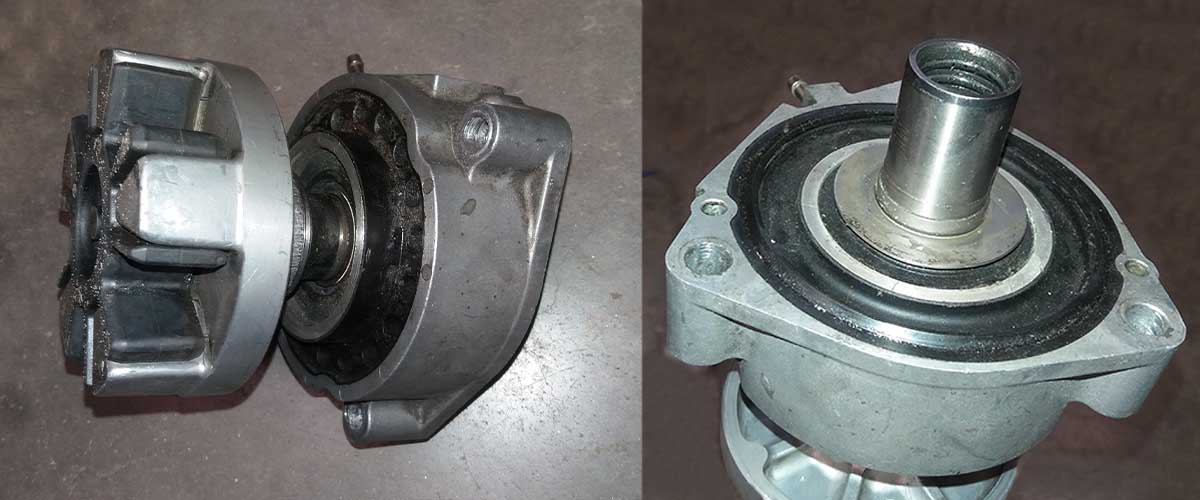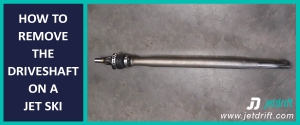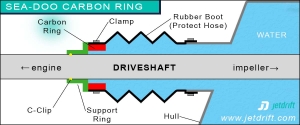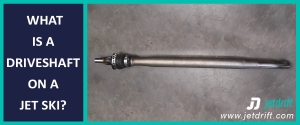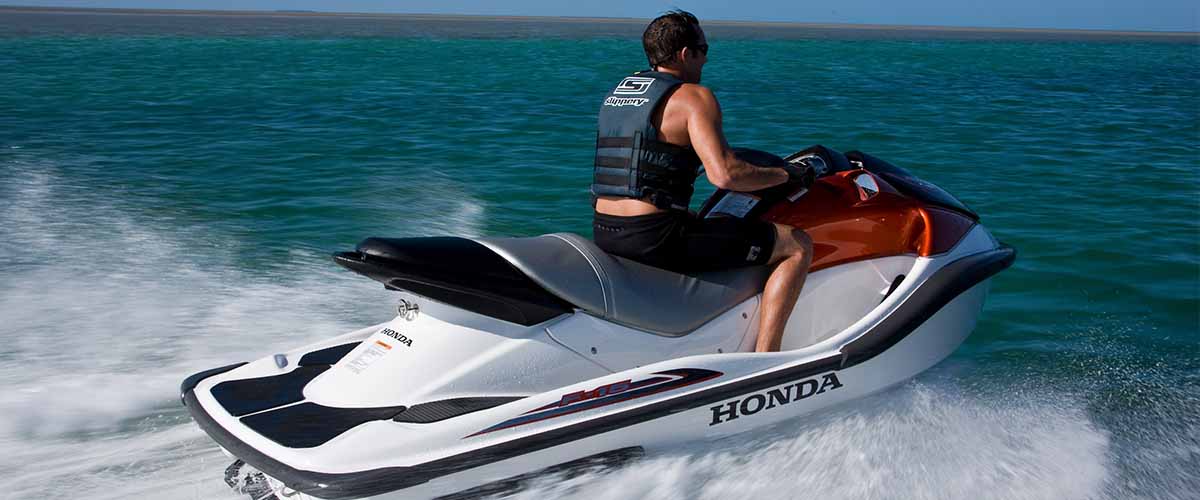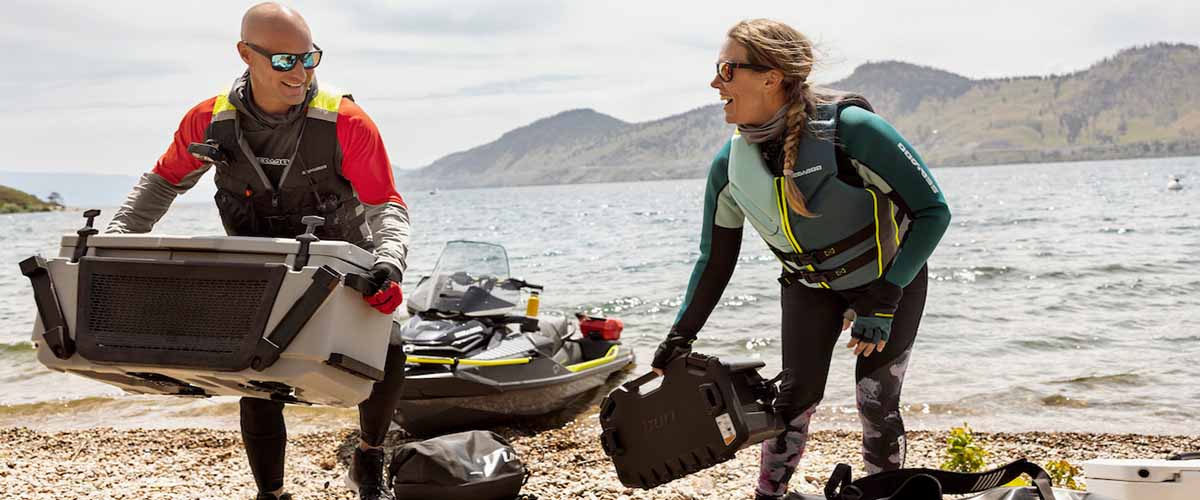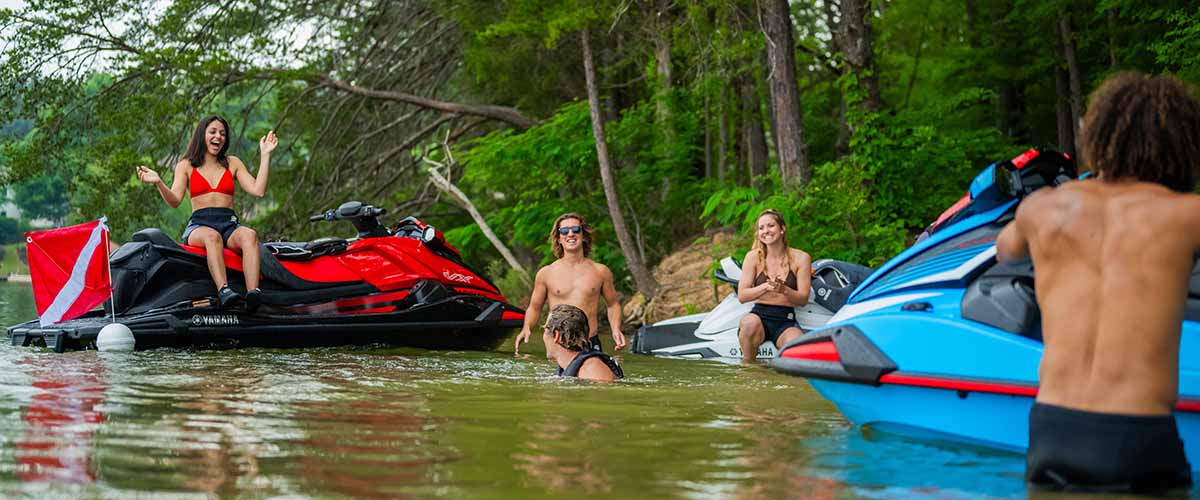What is a Coupler and Driveshaft Sealing on a Jet Ski? [Explained]
A coupler is the mechanical joint between the engine crankshaft and the driveshaft, commonly used on Yamaha WaveRunners, Kawasaki Jet Skis, and vintage 2-stroke Sea-Doos. In contrast, modern Sea-Doos are manufactured with a one-piece driveshaft featuring a less-durable carbon ring seal.
If you want to find out more about the coupler and the unique driveshaft sealing of Japanese PWCs, this post is for you.
We at JetDrift have compiled all you need to know under one roof!
What is the Coupler on WaveRunners and Jet Skis?
As a rule of thumb, each PWC features a direct drive, meaning that their engine is directly connected to the impeller via a direct shaft.
But the trick here is that the engine sits inside the ski while the impeller is located outside the hull. (There’s a nook at the bottom of each jet ski’s hull that encloses the pump housing the impeller.)
Due to this design, manufacturers have to cut a hole into the hull, so the driveshaft can protrude out. Since this hole is below the waterline, professional sealing is required to keep external water out.
Unfortunately, it’s not as simple as it seems at first since the driveshaft spins extremely fast.
Each manufacturer tries solving this issue in different ways, let’s take a closer look at each!
Sea-Doo Driveshaft Sealing
Sea-Doos use a carbon ring seal, including a special carbon ring mounted in a rubber boot, to solve this issue.
This rubber bellow is connected to the hull and wraps around the driveshaft. It also pushes the carbon ring against a metal ring (“hat”) attached to the drive shaft with a C-clip.
You can see the schematic drawing of the carbon ring system in this picture:
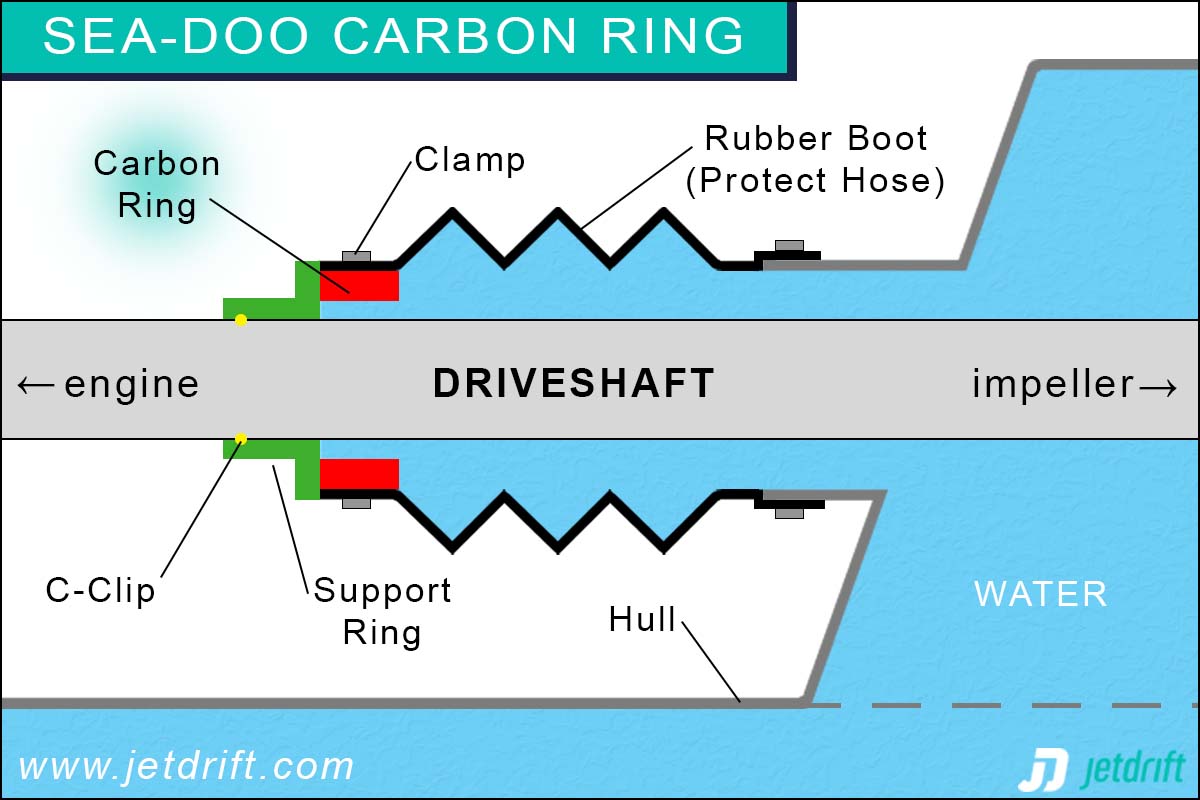
Sea-Doo Carbon Seal
The tight connection between these rings ensures proper sealing and keeps water out – as long as the carbon ring is in good shape.
Drawbacks?
The carbon ring is considered a wear item, so it must be replaced periodically. It can also get damaged due to engine misalignment, improper use, and so on. And a damaged carbon ring doesn’t provide a proper seal, resulting in a water leak.
(It’s good to know that vintage 2-stroke Sea-Doos came with a 2-piece driveshaft design with a coupler.)
WaveRunner Driveshaft Sealing and Coupler
The engieneers of Yamaha WaveRunners came up with a different solution to make their engine bay more waterproof. Instead of a one-piece driveshaft design, they split the driveshaft into two pieces.
The shorter shaft – known as the mid-shaft – is connected to the crankshaft via a coupler. The coupler is a unique mechanical joint that connects the crankshaft to the mid-shaft and transmits the power through the shaft housing.
You can see the entire assembly in this video:
There are many advantages to using a coupler in a jet ski drive unit, but the most important ones are as follows:
- Absorbs misalignment between the shafts
- Doesn’t transfer the engine heat towards the driveshaft
- Absorbs the vibration of the crankshaft
- Can connect different shafts of different diameters
A key part of the coupler is the rubber portion that prevents vibration and misalignment from being transmitted to the driveshaft.
On the other hand, it’s good to know that this rubber unit tends to age and break over time. Therefore, it has to be periodically replaced, just like the carbon ring on Sea-Doos.
The mid-shaft is attached to the crankshaft via this coupler, while its other end goes through a shaft housing (also knonw as a shaft holder or bearing housing). The mid-shaft is pressed into the bearings, ensuring a superb sealing around the mid-shaft.
This shaft housing features a double lip seal on its rear and is bolted to the inside of the hull. Finally, the driveshaft connects to the mid-shaft via a splined shaft connection while its other end is attached to the pump. (The impeller sits on a thread on the rear side of the driveshaft.)
For a better understanding, we’ve made a simple drawing of this assembly:
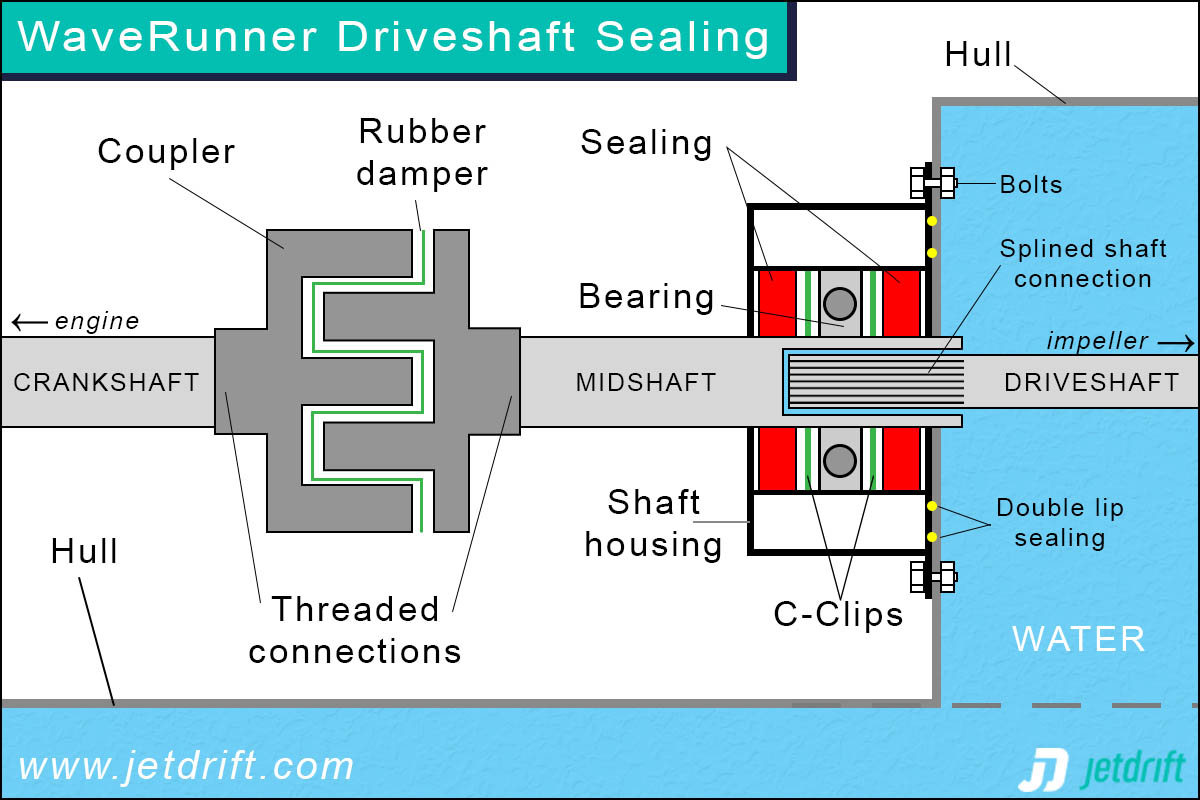
Coupler and driveshaft sealing on WaveRunners
Kawasaki Jet Ski Driveshaft Sealing
Kawasakis come with a one-piece driveshaft that features a splined rear end and a threaded front end. You can find a coupler attached to the threaded front end, which takes the power from the engine.
The rear splined end of the shaft is attached into the impeller. To make the ski waterproof the shaft goes throught a shaft holder (shaft housing), which is very similar to the shaft housing on WaveRunners.
This system has proven to be durable and waterproof, but if you want to pull out the driveshaft or its bearings be prepared to pull out the entire engine!
Sea-Doo Carbon Ring vs. Yamaha Driveshaft Sealing
When it comes to the Sea-Doo carbon ring vs. Yamaha driveshaft sealing debate, there is no question that the latter is the absolute winner. It’s more durable and reliable, resulting in higher safety and lower maintenance.
Sea-Doo’s carbon ring seal requires continuous attention and periodic replacement.
Besides normal wear and tear, a carbon seal can be damaged by engine misalignment, pump damage, or improper use. Due to the high risk of water leaking in, installing an aftermarket electric bilge pump is highly recommended for each Sea-Doo!
In contrast, Kawasaki and Yamaha driveshaft sealing is extremely reliable and requires minimal attention.
(Certain vintage 2-stroke Sea-Doos also utilized a drive shaft coupler, but the Canadian manufacturer decided to eliminate this key part on its later models for some mysterious reason.)
How to Remove the Coupler on a WaveRunner
Removing the coupler on a WaveRunner can be quite tricky, as it sits tightly on the crankshaft. In a nutshell, the key steps of the process are as follows:
- Block the pistons
- Apply some heat to the coupler
- Remove the coupler with a removal tool
Let’s get down to the nitty-gritty and discuss these steps in detail!
1. Blocking the Pistons
First, you have to block the pistons to prevent the crankshaft from spinning. To do this, best practice is to put a rope into the spark plug hole.
Keeping safety in mind, make sure that the piston covers the ports. Then, insert the rope into the spark plug hole until it fills most of the space above the piston. Pressing the piston against the rope in the chamber prevents the shaft from rotating.
2. Applying Some Heat
Unfortunately, the coupler is usually very tight, so you may want to apply some heat.
Try adding the heat to the center of the coupler, but be very careful near the crankshaft seal.
To prevent damage, it’s recommended that you cover the crank seal with a wet rag, but make sure it doesn’t keep the coupler cool.
3. Removing the Coupler
Applying enough heat often allows the coupler to very easily spin-off. If not, you can remove it using an impact driver with a special “coupler removal tool.”
This simple tool is available at most major retailers, but you can also weld one by yourself if you like building things.
You can also try to carefully release the coupler with a pry bar or a floor jack handle if there’s no special tool nearby.
Takeaway
As a takeaway, we’ve answered the most common questions on this topic.
What Does a Driveshaft Seal do on a PWC?
As the name suggests, driveshaft sealing on PWCs is a unique type of sealing intended to keep water out of the hull.
These sealing systems are attached to the inside of the hull while wrapping around the driveshaft.
The different driveshaft sealing systems by brand are as follows:
- Sea-Doo: Carbon ring seal with a rubber boot (+ coupler on some vintage models)
- Yamaha WaveRunner: coupler + mid-shaft + shaft housing
- Kawasaki Jet Skis: coupler + mid-shaft + shaft housing
Does Yamaha Use a Carbon Seal?
Unlike Sea-Doos, Yamaha WaveRunners don’t utilize a carbon ring seal. Instead, their driveshaft is sealed with a unique shaft housing (also known as bearing housing).
What is a Coupler on WaveRunners and Jet Skis?
The coupler on WaveRunners and Kawasaki Jet Skis is a mechanical joint attaching the driveshaft to the crankshaft. There’s also a short shaft inserted between these shafts, known as a mid-shaft.
Which is Better, Sea-Doo Carbon Ring or WaveRunner Driveshaft Sealing?
There’s no question that the driveshaft sealing of WaveRunners and Kawasaki Jet Skis are much better than Sea-Doo’s one-piece driveshaft sealed by a carbon ring. The key advantage of the driveshaft sealing system of the Japanese manufacturers are as follows:
- Higher safety (fewer risks of water leaks)
- Requires less maintenance
- More durable and tolerates rough handling better
- The coupler absorbs shaft misalignment, engine heat, and vibration
DISCOVER 2024 PWC MODELS Kawasaki, Sea-Doo, Yamaha, Krash…
